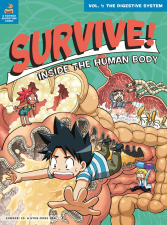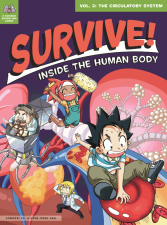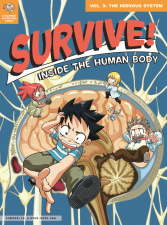Gi Hallmark | The Children’s Book Review | May 13, 2014
Survive! Inside the Human Body
What to expect: Facts and data about the digestive, circulatory, and nervous system; Full color illustrations, Adventure, Science, Fiction
Combining science and graphic novels is a fantastic way to capture and satisfy the natural curiosity and interest of early and middle readers. The Survive! Inside the Human Body trilogy presents a fun and practical way to introduce complex human biology concepts to readers interested in learning more about the digestive, circulatory and nervous systems. Originally published in Korea and translated into English, the series presents a cohesive, visually interesting and stimulating storyline that will appeal to a variety of audiences and learning methods.
In each of the three volumes, the main characters are the same; Geo (the protagonist), Dr. Brain (self-proclaimed genius/mad scientist), Kay (medical student/Dr. Brain’s voice of caution), and Phoebe (Geo’s friend and accomplice). Each volume has also been extensively reviewed by physicians for accuracy of information.
 Vol. 1: The Digestive System
Vol. 1: The Digestive System
By Gomdori Co., Illustrated by Hyun-Dong Han
The trilogy begins with Survive! Inside the Human Body Vol. 1: The Digestive System. Geo and Dr. Brain shrink and board a mini spaceship to take an inadvertent journey through Phoebe’s digestive system. Dr. Brain teaches Geo about the ins and outs of the esophagus, stomach, and intestines as they unsuccessfully try to escape and reunite with Kay. In the end, the pair leave the large intestine and travel to Phoebe’s blood vessels, which sets up the next book: Survive! Inside the Human Body Vol.2: The Circulatory System.
Ages 8 + │ Publisher: No Starch Press, Inc. │October 2013 │ ISBN: 978-1-59327-471-9
 Vol. 2: The Circulatory System
Vol. 2: The Circulatory System
By Gomdori Co., Illustrated by Hyun-Dong Han
Still searching for an exit and fighting for survival, Dr. Brain teaches Geo about the human circulatory system, including topics such as white blood cells, the liver, the heart, and hemorrhages. As they travel through Phoebe, they are able to get up close and personal in each lesson. Still unsuccessful in their bid to exit, Dr. Geo and Phoebe travel to Phoebe’s head and become entangled in a nervous system electrical signal that sends the duo to Phoebe’s brain.
Ages 8 + │ Publisher: No Starch Press, Inc. │October 2013 │ ISBN: 978-1-59327-472-6
 Vol. 3: The Nervous System
Vol. 3: The Nervous System
By Gomdori Co., Illustrated by Hyun-Dong Han
In the final book of the trilogy, Survive! Inside the Human Body, Vol. 3: The Nervous System, Dr. Brain and Geo are trapped in Phoebe’s brain, where they explore and learn about the nervous system. The trilogy ends dramatically with an MRI that allows Dr. Brain and Geo to become free, with the introduction of an evil research director, and with the discovery of a brain tumor in Phoebe during the MRI. Phoebe’s life is ultimately saved because of the MRI, which would have never been performed had Dr. Brain and Geo not taken their inadvertent journey.
Ages 8 + │ Publisher: No Starch Press, Inc. │October 2013 │ ISBN: 978-1-59327-473-3
The Survive! Inside the Human Body series includes expressive, colorful illustrations and is fortified with helpful facts, charts, and photographs. With increased focus on STEM in classrooms, graphic novels can an effective tool in engaging reluctant readers and learners. Though the narrative can get silly at times, this series is a fantastic reference for readers and educators seeking a clever fictional framework for learning science.
You may also like:
The Stuff of Life: A Graphic Guide to Genetics and DNA, by Mark Schultz, illustrated by Zander Cannon and Kevin Cannon (Hill & Wang, 2009). (Ages 15 and up)
The Basics of Cell Life with Max Axiom, Super Scientist, by Amber Keyser, illustrated by Cynthia Martin and Barbara Jo Schulz (Graphic Library, 2009). (Ages 8-14)
Survive! Inside the Human Body, by Gomdori Co. and illustrated by Hyun-Dong Han, was reviewed by Gi Hallmark. Follow along with our “Science Books” and “Health Books” to discover more books on the human body and similar topics.
